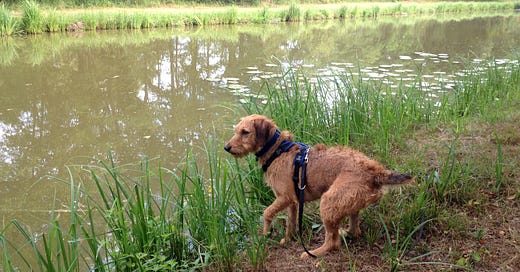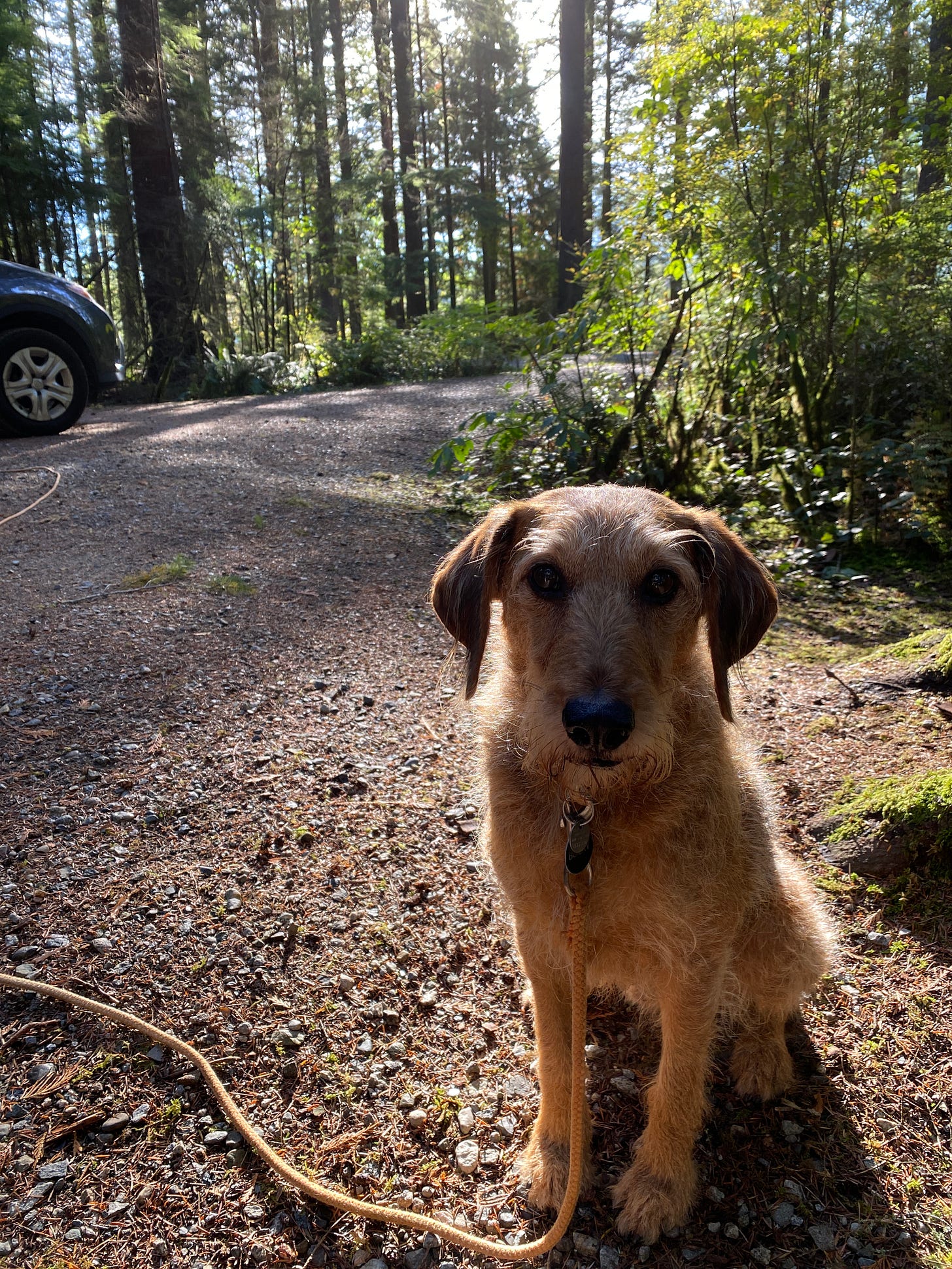The first year I had Bucky I was walking him on a long leash, when a random passerby mansplained to me that “long leashes are only for training recall”. Okay then, bye. Sometimes there is no point arguing, and I just wanted to get on with my day.
Have I used the long leash perfectly with Bucky? No.
Has it been useful in multiple ways? Absolutely.
Let’s explore how and why you would use a long leash when going outdoors with your dog.
Early days of using the long leash with Bucky, circa 2015.
Long leashes can help your dog… learn the recall
I’ll give it to that random passerby, you *can* use the long leash to train your dog a recall cue. It’s a way to set your dog up for success, especially if you don’t have access to an enclosed outdoor area. The point is not to drag your dog to you to teach them a recall -the long leash should stay slack as much as possible. The goal of the long leash when teaching a recall is to:
- make coming back to you the most rewarding option,
- and prevent your dog from being rewarded by ignoring you. You don’t want your dog to learn that ignoring you and chasing after squirrels is the more rewarding option.
You can use long leashes for teaching stay or any other cues you want your dog to respond to from a distance (wait, sit, down, etc.).
Long leashes can help your dog… walk close to you on trail
Walking on leash doesn’t come naturally to dogs, but you can teach them -with positive reinforcement- to respond to the slightest tug of the leash. It’s best to start at home with few distractions, and when you’re ready to take it outside you can use the same principle with the long leash. If the leash is loose they get to explore, if the leash is taut they need to pay attention to you.
Walking your dog with a long leash outdoors is a great way to give them more freedom to explore, while keeping them and wildlife safe, especially for dogs with a high prey drive. I’ve seen people use long leashes on trail in one of two ways:
1. The person lets the long leash drag on the ground and steps on it gently to act as a brake if the dog is getting too far. Careful with fast dogs! Once the leash moves past you, it’s up to the dog when they’ll come back, which I’ve learned the hard way. This works best on open, smooth terrain.
2. The person keeps the leash in hand and coils up or uncoils the leash depending on how far the dog is exploring. This is a bit more work as they have to manage the leash to keep it slack without it dragging on the ground too much. It works better on uneven, closed or crowded terrain, where a leash dragging on the floor would snag on rocks, roots and people’s legs.
When using a long leash on trail be careful during dog greetings. It might seem like a good idea to drop the leash on the ground but long leashes can get entangled in dogs’ feet and you want to avoid either dog feeling trapped in the situation.
Whatever training you are using the long leash for, make sure you know what your dog finds rewarding and use that to encourage the “right” behaviours.
Long leashes can help your dog… gain confidence in scary situations
Short leashes are helpful to help dogs and humans navigate crowded sidewalks and various urban settings. They can feel quite restrictive for dogs as their freedom of movement is limited to a measly 6 feet, if that. That restriction can make situations dogs find scary even more stressful. That’s why long leashes can be recommended to help dogs gain confidence.
For example, long leashes are an integral part of Behaviour Adjustment Training (BAT). You give your dog enough slack and time to explore a scary situation at a distance (e.g. another dog in the park), far enough that the situation doesn’t trigger an emotional reaction. Over a number of sessions this allows them to slowly realize the scary situation is not so scary after all.
Bucky is scared of crossing bridges, especially with rushing water underneath. Off leash or on a long leash, he is much more likely to be brave and cross the bridge, because he can move at his own pace, on whatever side of the bridge he decides is safest (I’m not always sure how he decides that to be honest).
Long leashes can help your dog… stay safe while camping
Exploring the outdoors with dogs is fantastic. Obviously I think so, otherwise I wouldn’t be here, writing to you. Chilling out in the outdoors, enjoying a nice long break near a lake, or a meal at camp on top of a mountain, or at a drive-in campground… delightful. (I’m getting distracted by day dreams of camping trips past and future here. Shake it off, Flo.)
We can talk about how to help your dog settle in the outdoors another time. The long leash won’t magically get your dog to stop barking every time you dare take a 10-second break while hiking. The long leash, however, will help your dog stay safe and close, without you having to keep an eye on them every second. You can tie the one end to your dog’s harness and the other to a picnic table, tree, or a metal anchor you’ve screwed in the ground, and voilà! If your dog is intent on escaping the campground however, make sure you choose a metal leashes. Material like ropes can be chewed through in a bite or two.
What type of long leash is best for your dog?
If you’re planning on giving long leashes a try, here is more information to help you make an informed purchase. I don’t include retractable in the category of long leashes, because they are always taut and therefore counter-productive for the training we’ve discussed above. I’ve never seen metal leashes used other than as tether so I can’t make an informed comment about other uses for it, but my uninformed comment is that it might be impractical if not unsafe.
Long leashes used in training are generally made of nylon or Biothane (or other water-repellent material). Here are the highlights:
Nylon
Light, heavy when wet
Gathers dust, dirt and water
Not easy to clean
Knots can form accidentally and impact durability
Biothane or other water-repellent material
Heavier
Water-resistant
Easy to clean
Happy training!




